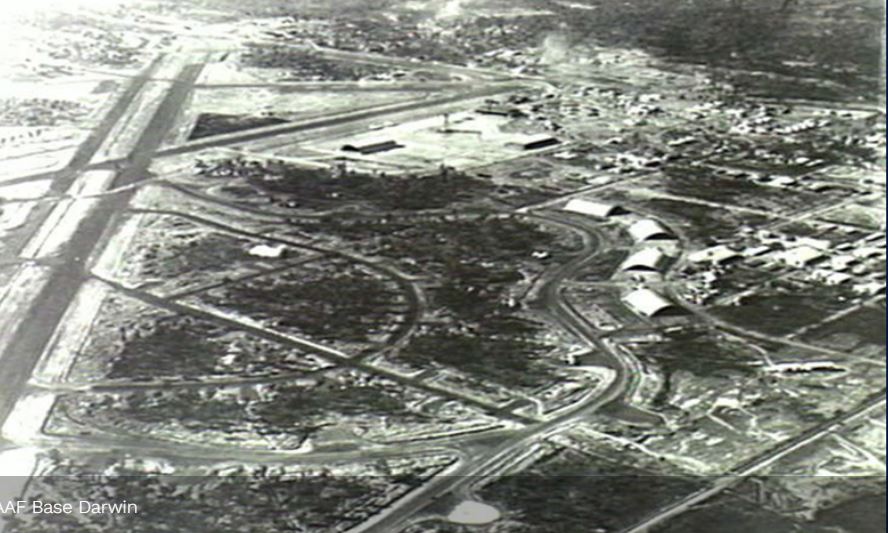RAAF Base Darwin
From Our Contribution
 | |
Brief History
RAAF Stntion Darwin was formed on 1 June 1940. Almost 3000 acres of woodland had been approved for purchase in December 1937. The Base was still under construction when the first RAAF element, 12 Squadron, arrived in 1939. The aircraft were housed in a Guinea Airways hangar on the civil aerodrome because the RAAF facilities were not yet complete. Operations at Darwin were entirely the province of No. 12 Squadron until the formation of station headquarters in June 1940. The Squadron then split up with some of the offices moving to headquarters, while others remained on 12 Squadron's strength, and still others moving to a new squadron, No. 13 (City of Darwin) Squadron RAAF.
Station headquarters carried out its work from a so called temporary hutted camp until August 1940, when it moved into a newly erected administrative building at the RAAF aerodrome. The war alert saw both 12 and 13 Squadrons engaged in patrols over the sea, the latter flying Lockheed Hudson aircraft. The Pacific War began in the early hours of 7 Dec 1941. Singapore fell on 15 Feb 1942 and Darwin experienced its first air raid four days later. Over 1OO enemy aircraft made two separate attacks which destroyed 23 Allied aircraft, sank eight ships and killed 255 people. Japanese raids continued until November 1943, 64 in total. While damage to the installations was extensive, casualties were generally light. Satellite airfields were established at Batchelor, Millingimbi, Livingstone, Strauss, Fenton, Long, Gove, Coomalie, Hughes and Groote Eylandt
By January 1943 Darwin and the surrounding areas boasted an array of combat aircraft including Bristol Beaufighters from No. 31 Squadron RAAF, CAC Boomerangs from No. 83 Squadron, Curtis P-40 Kittyhawks from No. 76 Squadron RAAF and No. 77 Squadron RAAF, North American B-25 Mitchells from No. 18 (Netherlands East Indies) Squadron RAAF and Consolidated B-24 Liberators from 319 Squadron (USAAF). These were soon joined by three squadrons of Supermarine Spitfires No. 52 Squadron (RAF), No. 452 Squadron RAAF and No 457 Squadron RAAF. The Allied bombers harassed positions in New Guinea, New Britain and Timor, whilst the fighters were generally able to get the better of incoming raiders. On 20 June the Spitfires recorded one of their most successful actions above Darwin, 14 enemy planes being downed for the loss of two of their own number. Japanese attacks became less and less frequent as the year progressed.
By 1944 aircraft from Darwin and the surrounding airfields maintained operations across an area ranging from Micronesia to Malaya. Consolidated PBY Catalinas from No. 43 Squadron RAAF joined No. 11 Squadron RAAF and No. 20 Squadron RAAF mine laying around Borneo and the Carolines, while Liberators from No. 21 Squadron RAAF, and No.s 23 and 24 Squadrons carried out attacks on enemy shipping. The following year saw the Liberators attacking Japanese-held airfields in Java and the Catalinas operating as far north as China and Hong Kong. With the cessation of hostilities in August 1945, Darwin became a port of call for parties travelling to and from territories formerly occupied by the Japanese. The Base has served as a major transit centre ever since.
Unit Personnel
- Joseph Watson (RAAF) 2 Feb 1942 - 19 Apr 1942
- Keith Robert Mills 7 Dec 1945 - 3 Mar 1946
- Robert Edward Gray 12 Sep - 2 Dec 1944
Notes
Content has come from Units of the Royal Australian Air Force - A Concise History - Volume 2 Fighter Units - Australian Government Publishing Service - 1995 pages 128 - 131